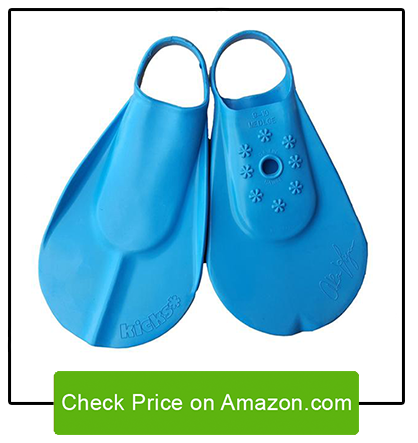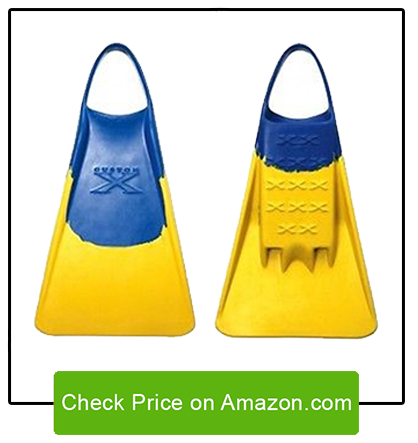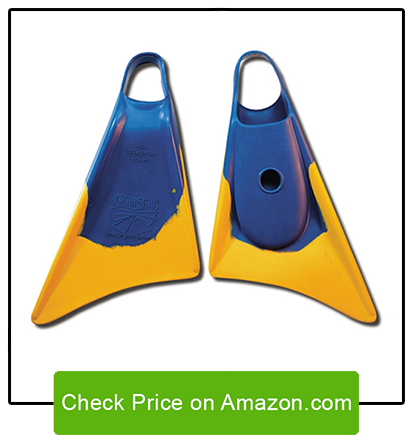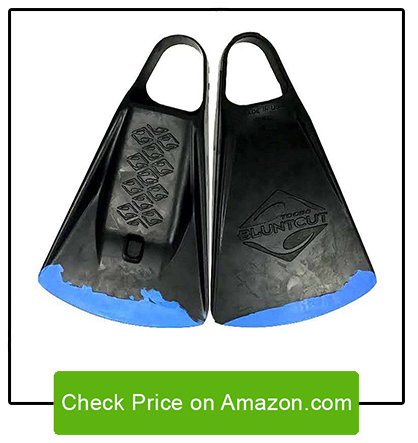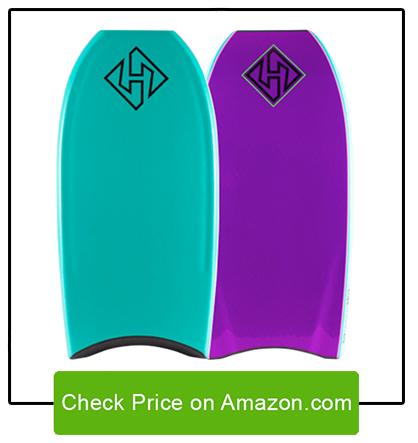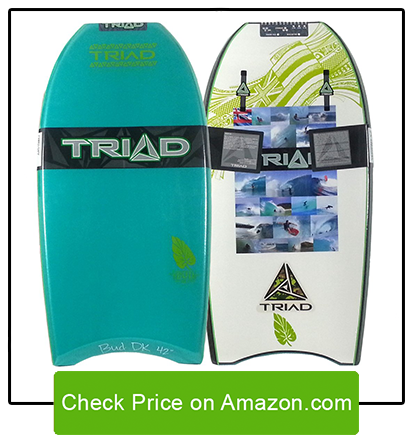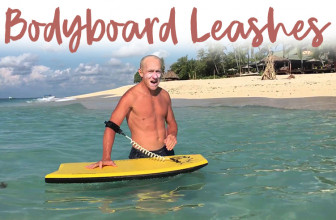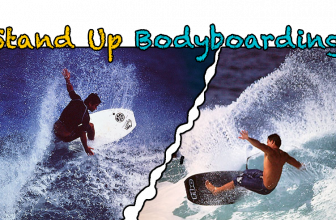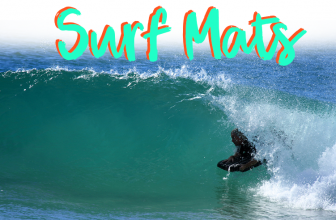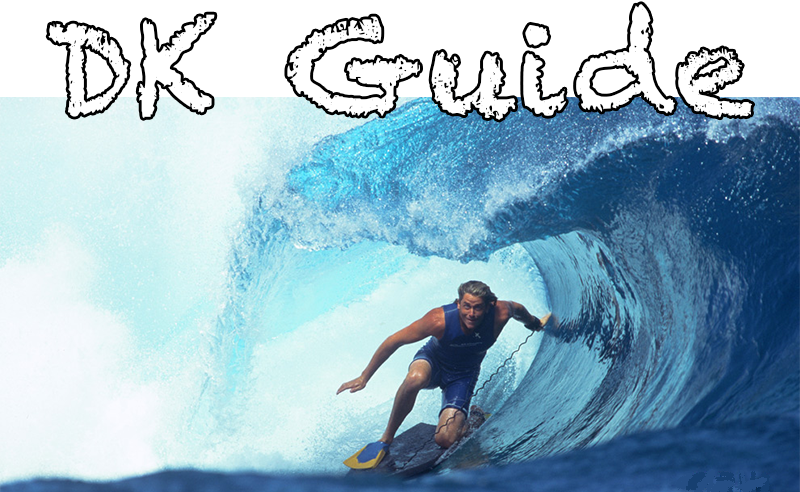
Dropknee, or DK, is a technique that combines surfing with bodyboarding and kneeboarding.
More...
While Dropknee has been around since the late 1970’s, it didn’t gain popularity until about ten to fifteen years later.
Nowadays, DK bodyboarding is all the rage, and it has earned its own place amongst other wave-riding sports.
With the evolution of DK techniques came modifications not only to the style and execution of moves, but to the gear used as well.
Best Dropknee Fins
[go_pricing id="fin_cramps"]
Kicks Fins
If you cannot seem to find fins that don’t hurt to wear, try these. Comfortable and easy on the feet are trademark characteristics.
However, a sacrifice for comfort is power and thrust. This lightweight rubber fin is very flexible, and has a short rounded tip for quick, snappy kicks and turns.
For fin strength and stability, there are raised ridges along the blade's sides and down its middle.
Water drains through a circular hole in the middle of the foot pocket. These fins are symmetrical, come in many color options, and they float!
Custom X Fins
Another comfortable, lightweight, all-rubber fin is the Custom X Fin. Their broad base and short blunt blade shape are hydrodynamic, providing added speed.
Two drain holes near the toes with channeling increase the water flow, keep sand from accumulating, and additionally help with hydrodynamics.
Ergonomic A-frame ankle straps. A soft, gripping footbed contrasts a stiffer blade for excellent thrust with maximum comfort. Floats for easy retrieval should the ocean swipe them from your feet.
Churchill Fins
Excellent fins for beginners and pros alike. Asymmetric with a long outer side rail that comes to a pointed tip give these blades medium power for catching a wave and then quickly paddling back out for another.
Despite the irregular shape, these fins are incredibly balanced. They are moderate in weight given their rigid design for added thrust.
These fins provide comfort with power, making them great for learning and improving your DK skills.
The drain hole is in the middle of the foot pocket and is a bit larger than on other fins; it lets water and sand through, yet can occasionally trap a toe in larger wave wipeouts. They also float!
Toobs Blunt Cuts
These are very popular fins among DK enthusiasts.
You get both speed and power from their blunt cut and hydrodynamic shape. A rigid symmetrical blade but soft foot pocket equates to a comfortable fit with great performance.
Excellent for the beach walk and paddle out to the lineup, as well as for catching waves and sporting fancy maneuvers.
The drain hole is a unique “sand-spit” vent to remove not only water and sand, but rocks and other larger debris as well. Yes, they float!
Best Dropknee Bodyboards
Hubboards Dubb
You have three choices from the Dubb edition of Hubboards; the PE DLX, PP HD, and the PP PRO PLUS. All three have designs that generate speed on a wave while allowing for control in movements.
The PE DLX is an all-around fun board that features the Dubb Bat Tail, graduated channels for stability and control on wave faces, a polyethylene core with double SSS stringer, and HD slick for great durability and less friction.
At 42” the PE DLX is good for prone and dropknee boarding.
The PP HD has a crescent tail, a kinetic core made from Arpro Polypropylene resin, double SSS stringer for enhanced performance and control, and HD slick.
The PP HD is good for prone, dropknee and standup at 41”, 42” or 44” sizes available.
The PP PRO PLUS with its crescent tail is for hardcore DK bodyboarders that also ride prone. The PRO PLUS has a polypropylene core, surlyn slick, double SSS stringer and wire-like plastic mesh between the slick and core for incredible stiffness, flexibility and projection. Available in sizes 40.5", 41.5" and 42.5", this board also has a contoured deck for maximizing the grip of both hands and knees.
Triad-Bud Miyamoto DK
A versatile board for prone, DK and standup, the Triad-Bud Miyamoto Pro features a crescent tail, surlyn slick bottom and two types of stringer options depending upon board size; double stringers in their 41” and 42” sizes and triple stringers in their 43” size.
This board has a polypropylene core, a lifted nose, and a flat surlyn slick bottom specifically made to fit vector system fins.
Dropknee Bodyboard Shape & Dimensions
Not all wave enthusiasts are created equal, hence the variety in the shapes and dimensions of our board choices.
If you are just learning, a longer board will give you stability.
Shorter boards are easier to maneuver but with less flotation, you also get less lift and speed on a wave.
Typically, because a DK rider puts weight toward the back of the board, a shorter nose width, a wide-point distance from the nose that is further back, and usually a wider, crescent-shaped tail and wider width is preferred.
Your weight, skill level, and type of waves you surf will determine other factors such as channel design, core type, stringer options, and rail ratio.
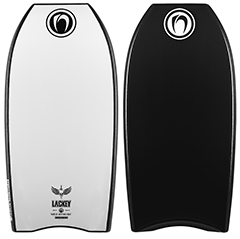
How to Dropknee Bodyboard – Tutorial
You need speed, balance and proper knee placement for DK bodyboarding.
Weight positioning is critical for controlling the board and your maneuvers, and rail use is important.
Paddle quite hard to generate speed.
When the board catches the wave, use your hands on the nose of the board to slide your knees up into a wide stance so your lower legs are close to the rails.
From this position, if you’re a natural on a right-hand wave, your right hand holds the top right corner of the board while your left hand is applying pressure to the left rail midway between the tail and nose for better control of the board while you’re lifting up your left leg.
Keep the nose of your board flat to the water while getting up to keep forward momentum and speed. Move quickly and swiftly, try to avoid jerking the board around. Swing your left leg around and place the food about a palm’s distance from the nose, using your left hand for compensating and balance.
Remove your right hand and, when you feel stable, remove your left hand. The right foot is in the water with your fin acting as a rudder. Be sure to reverse these body, hand and arm positions for a left-hand wave and if you are goofy! If goofy, put the right foot at the front.
Find the knee placement that works best for you – farther from the inside rail will cause you to slide around a lot, yet too close will drag the rail and slow you down. Do not get into the habit of sitting on your calves. The board’s nose should be angled about 45-degrees from the wave.
Lean in toward the face and use your arms and upper body to maneuver. Keep weight on the nose to maintain speed and balance.
FAQ
Dropknee vs regular prone bodyboarding?
Prone bodyboarding is preformed lying down on the board. Once the wave catches the board, the lower part of your body stays in the water while your upper body props up on your forearms. Steering and executing tricks requires the use of both upper and lower body. DK bodyboarding takes your body out of the water; one knee and one foot rests on the board. The back foot trails in the water with the fin used as a rudder. Steering and and pulling off tricks is done by shifting your body weight and predominantly using the rails of the board to cut lines.
Is it hard to dropknee bodyboard?
Any sport is hard when first learning. Getting the right gear, the right instructions, and heaps of practice will make all the difference. Having patience, the right attitude, and being persistent will go a long way also!
Do I need dropknee specific fins and bodyboard to drop knee?
No, but learning skills will come easier if you start out with gear that makes it more enjoyable to learn rather than more complicated. For example, longer fins may catch and trip you on the pop-up or if you have some weight on you, a lighter, smaller board will be harder to generate enough speed to catch and stay on a wave.
To check out some of our favorite bodyboarding fins, make sure to head over to our best bodyboarding fins main guide!
Why not just kneel on both knees instead of dropknee?
From a technical standpoint, DK makes more sense than kneeling because you have leverage with the back foot. A DK rider will straighten the back leg throughout big turns, similar to a roundhouse turn on a surfboard. It’s the ankle that does the pushing and the fin is used as an extension of the rail.
Can you do the same tricks with dropknee bodyboarding as a surfer?
Yes. While the maneuvers and technique are about the same, the array of tricks a DK bodyboarder can do is much wider than what a surfer can pull off. The trade-off – it’s a bit more difficult to execute those tricks, so will take more time to learn and perfect.
What’s the hardest part about learning dropknee bodyboarding?
The most difficult part is getting that forward fin out of the water and onto the board. Dragging the fin will slow your speed and stall your board. Emphasize the lifting of the leg and grab onto your rails firmly. Out of the water, stretch to gain flexibility and exercise to strengthen leg and core muscles.
Do I wax my dropknee bodyboard, and how do I apply it?
Wax your board to improve grip, but avoid waxing the entire surface, which can hinder the ability to execute moves. For DK boards, wax the nose and tail but only a section that is about 1/3 from the top and bottom, respectively. Importantly, though, just wax half of that 1/3 section depending upon whether you are regular (left half) or goofy (right half). Include the rail portions in that 1/3 section where hands are placed.
Are boards with channels a good choice?
Channels are contours along the bottom of the bodyboard. They channel water under the board and preference will determine if you want them or not. They are helpful in smaller waves and give an extra bite in steep barrel sections. However, they can create drag that slows your speed. If you choose to go that route, look for a board with with shallow blended channels.
Wrist or bicep leash?
Either will work and both have pros and cons. A wrist leash is more comfortable and easier to put on and take off. However, in this position, the leash can coil around the arm during some tricks. Using a bicep leash makes paddling easier; being tied to the upper arm keeps it out of your way, but it may feel tight whenever your bicep flexes.

